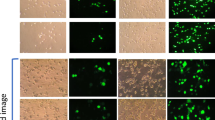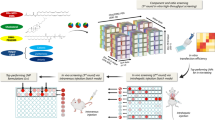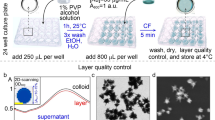Abstract
Poor transfection efficiency is the major drawback of lipofection. We showed previously that addition of transferrin (TF) to Lipofectin enhanced the expression of a reporter gene in HeLa cells by 120-fold and achieved close to 100% transfection efficiency. The purpose of this study was to determine whether TF and other ligands could improve the efficiency of lipofection in lung carcinoma cells. Confluent A549, Calu3, and H292 cells were transfected for 18 hours with a plasmid DNA (pCMVlacZ) using Lipofectin plus TF, insulin, or epidermal growth factor as the vector. The transfected cells were assessed for transfection efficiency by β-galactosidase activity (light units/μg protein) and the percentage of blue cells following 5-bromo-4-chloro-3-indolyl β-D-galactopyranoside staining. Lipofectin supplemented with epidermal growth factor yielded the largest enhancement of lipofection efficiency (≤23-fold over that by Lipofectin alone) in all three cell lines. Insulin significantly enhanced the lipofection efficiency in A549 and Calu3 cells but not in H292 cells, whereas TF showed significant lipofection efficiency-enhancing effect in Calu3 and H292 cells but not in A549 cells. The transfection efficiency correlated well with the amounts of DNA delivered to the nucleus as well as the amounts of the receptor. These results indicate that the gene delivery strategy employing ligand-facilitated lipofection can achieve high transfection efficiency in human lung carcinoma cells. In addition, enhancement of the expression of the receptor may be a possible strategy for increasing the efficiency of gene targeting.
This is a preview of subscription content, access via your institution
Access options
Subscribe to this journal
Receive 12 print issues and online access
$259.00 per year
only $21.58 per issue
Buy this article
- Purchase on Springer Link
- Instant access to full article PDF
Prices may be subject to local taxes which are calculated during checkout
Similar content being viewed by others
Author information
Authors and Affiliations
Corresponding author
Rights and permissions
About this article
Cite this article
Yanagihara, K., Cheng, H. & Cheng, PW. Effects of epidermal growth factor, transferrin, and insulin on lipofection efficiency in human lung carcinoma cells. Cancer Gene Ther 7, 59–65 (2000). https://doi.org/10.1038/sj.cgt.7700092
Received:
Accepted:
Published:
Issue Date:
DOI: https://doi.org/10.1038/sj.cgt.7700092
Keywords
This article is cited by
-
p53 gene therapy of human breast carcinoma: using a transferrin-modified silica nanoparticles
Breast Cancer (2016)
-
Radiation improves gene delivery by a novel transferrin-lipoplex nanoparticle selectively in cancer cells
Cancer Gene Therapy (2008)
-
Activation of CMV promoter-controlled glycosyltransferase and β -galactosidase glycogenes by butyrate, tricostatin A, and 5-Aza-2′-deoxycytidine
Glycoconjugate Journal (2005)
-
BCL-2 antisense and cisplatin combination treatment of MCF-7 breast cancer cells with or without functional p53
Journal of Biomedical Science (2005)
-
Systemic genetic transfer of p21WAF−1 and GM-CSF utilizing of a novel oligopeptide-based EGF receptor targeting polyplex
Cancer Gene Therapy (2003)



